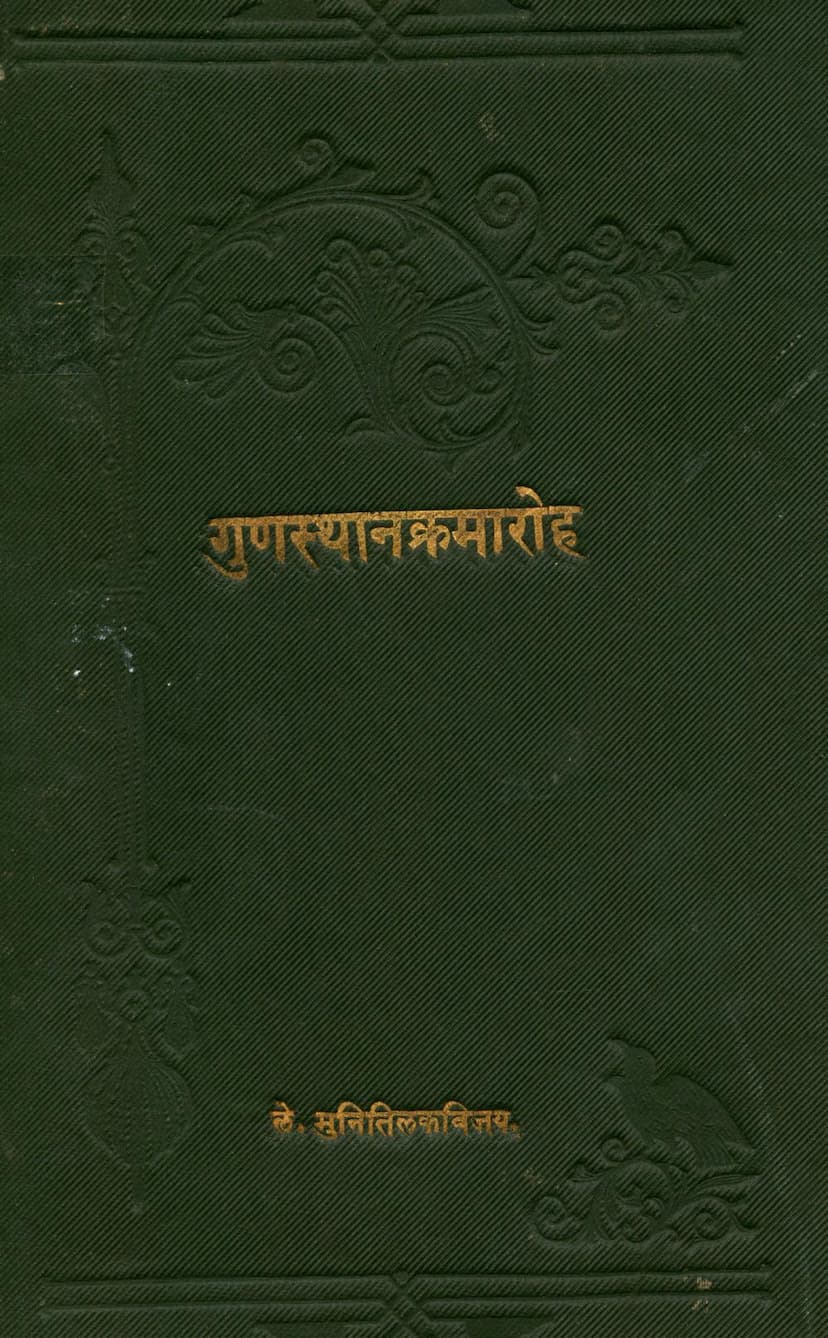Gunsthan Kramaroh
Added to library: September 1, 2025

Summary
Here's a comprehensive summary of the Jain text "Gunsthan Kramaroh" by Muni Tilakvijayji, based on the provided pages:
Book Title: Gunsthan Kramaroh (Ascent of the Stages of Vocation) Author: Muni Tilakvijayji (translated from Muni Tilakvijayji Punabi) Publisher: Shri Atmattilak Granth Society Catalog Link: https://jainqq.org/explore/022003/1
Overview:
"Gunsthan Kramaroh" is a Jain text that meticulously details the fourteen stages of spiritual progress (Gunsthan) that a soul traverses on its path to liberation (Moksha). The book, translated into Hindi by Muni Tilakvijayji, aims to elucidate the profound concepts of Jain philosophy regarding the soul's journey from ignorance and bondage to omniscience and freedom. It explains how the soul, clouded by karmas, gradually sheds these karmic veils to reveal its inherent pure qualities.
Core Concepts Explained:
- The Nature of the Soul (Atma) and Karma: The book begins by establishing the distinction between the soul (Atma), which is formless and possesses qualities like knowledge and perception, and karma, which is formful, inert, and obscures the soul's true nature. It emphasizes that the soul's association with karma is beginningless but not endless.
- The Fourteen Stages (Gunsthan): The central theme is the detailed explanation of each of the fourteen Gunsthan, outlining the spiritual state, the predominant emotions and dispositions, the types of karmas being bound, experienced, and suppressed, and the subtle changes in the soul's consciousness as it ascends through these stages.
Summary of the Stages (Gunsthan) as Described:
The text systematically explains the characteristics of each of the fourteen stages, providing detailed explanations, examples, and philosophical insights. Here's a breakdown of the initial stages covered in the provided text:
-
First Gunsthan (Mithyatva): This is the stage of complete ignorance and delusion. The soul incorrectly identifies with the non-soul, misunderstands the true nature of reality, and is completely under the influence of false beliefs. This stage is characterized by incorrect faith in false deities, gurus, and religions.
-
Second Gunsthan (Sāsvādana): This stage is described as a fleeting experience of tasting (sāsvādana) right faith (samyaktva) after partially overcoming delusion, but with a subsequent fall back into delusion. It's a transient state where the soul experiences a glimpse of truth but remains impure.
-
Third Gunsthan (Mishra): In this stage, the soul experiences a mix of right and wrong beliefs. It's a state of wavering where both true and false perceptions coexist, making it a transitional phase.
-
Fourth Gunsthan (Avirati Samyagdr̥ṣṭi): This is the stage of a person with right faith who has not yet renounced worldly attachments or vows. While holding the right view of reality, the soul still possesses worldly desires and has not yet attained complete self-control.
-
Fifth Gunsthan (Deśavirati / Shrāddhatva): This stage represents partial renunciation, typically associated with lay followers (Shravakas). The soul observes limited vows and practices, leading to partial self-control and purity. The text extensively details the twelve vows (Aṇuvrata, Guṇavrata, Śikṣāvrata) that a Shravaka observes at this stage, along with the five types of vows and their limitations. It also discusses the concept of Guṇasthan (stages of virtue) and Pratimā (vow-related practices).
-
Sixth Gunsthan (Pramatta Śramaṇa): This is the stage of an ascetic (Śramaṇa) who has taken vows but is still prone to "pramāda" (carelessness, heedlessness) due to the influence of passions. While striving for spiritual progress, the soul is still susceptible to minor lapses. The text elaborates on the four types of Ārtta (sorrowful) and Raudra (fierce) meditations that dominate this stage, along with a mention of lesser importance of Dharma (virtuous) meditation.
-
Seventh Gunsthan (Apramatta Śramaṇa): This is the stage of an ascetic who has overcome carelessness and is diligently engaged in spiritual practices. The soul is now free from the influence of gross passions and is dedicated to the path of liberation. The text highlights the absence of pramāda and the presence of virtues like compassion, equanimity, and detachment.
-
Eighth Gunsthan (Apūrvakaraṇa): In this stage, the soul begins to experience entirely new and unprecedented spiritual states. It is characterized by the cultivation of unique spiritual insights and practices that lead to the shedding of subtle karmic particles. This is where the process of Śreṇi (ascension on a spiritual ladder) begins.
Key Themes and Contributions:
- Systematic Explanation: The book provides a systematic and detailed explanation of the fourteen stages, making a complex philosophical concept accessible.
- Practical Guidance: It offers practical guidance on the vows, practices, and mental states associated with each stage, particularly for lay followers in the initial stages.
- Emphasis on Karma: The text underscores the crucial role of karma in the soul's journey, detailing how different karmic dispositions lead to different stages of progress or regress.
- Spiritual Ascent: The "Kramāroha" (ascent) aspect emphasizes the gradual and progressive nature of spiritual development, where each stage builds upon the previous one.
- Influence of Meditation: The book highlights the importance of various forms of meditation (Dhyana) in advancing through the Gunsthan, particularly the progression from Ārtta and Raudra to Dharma and eventually Shukla Dhyana.
- The Role of the Guru: The text implicitly emphasizes the importance of a spiritual guide (Guru) in navigating these stages, as indicated by the devotional aspects and the explanations derived from ancient texts.
Significance:
"Gunsthan Kramaroh" is a foundational text for understanding the path to spiritual liberation in Jainism. It provides a roadmap for spiritual aspirants, detailing the transformative journey of the soul from a state of bondage to the ultimate freedom of omniscience and bliss. By explaining the subtle shifts in consciousness and the corresponding karmic interactions at each stage, it offers deep insights into the Jain understanding of spiritual evolution.